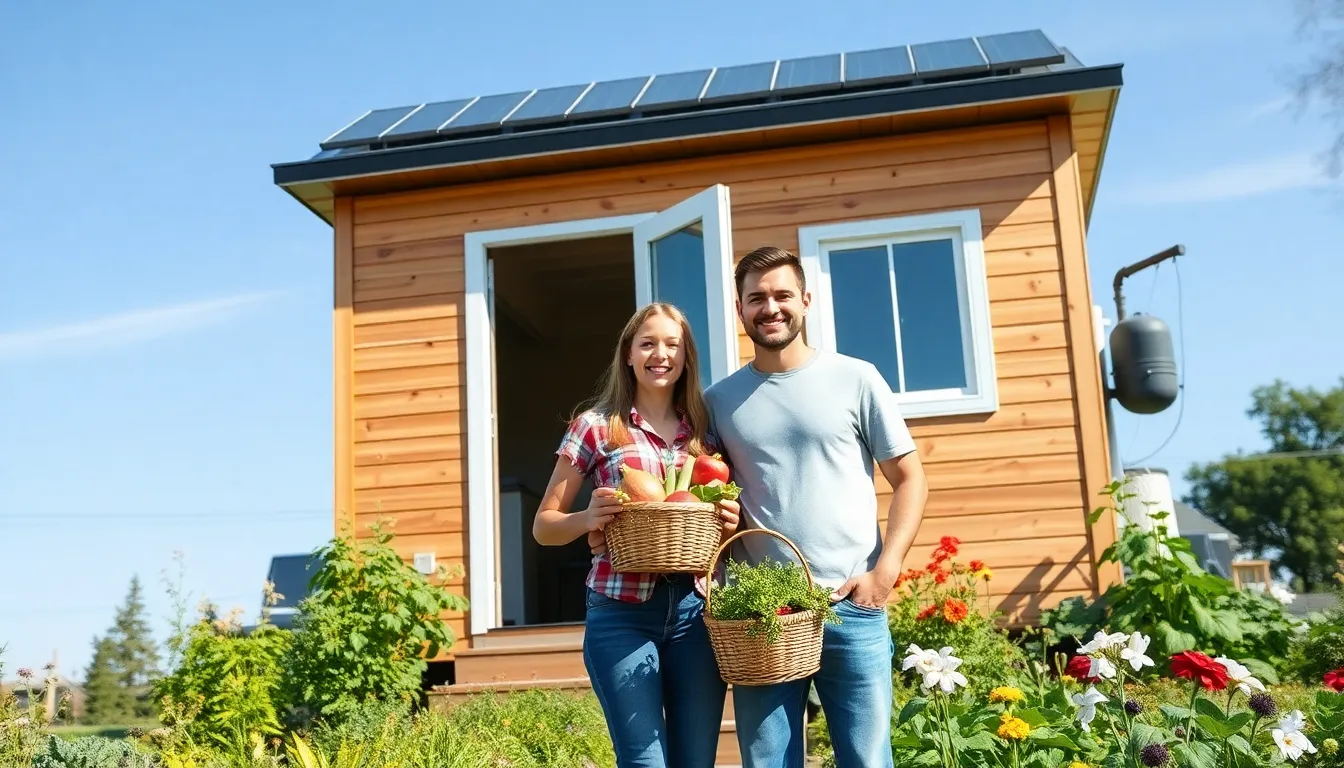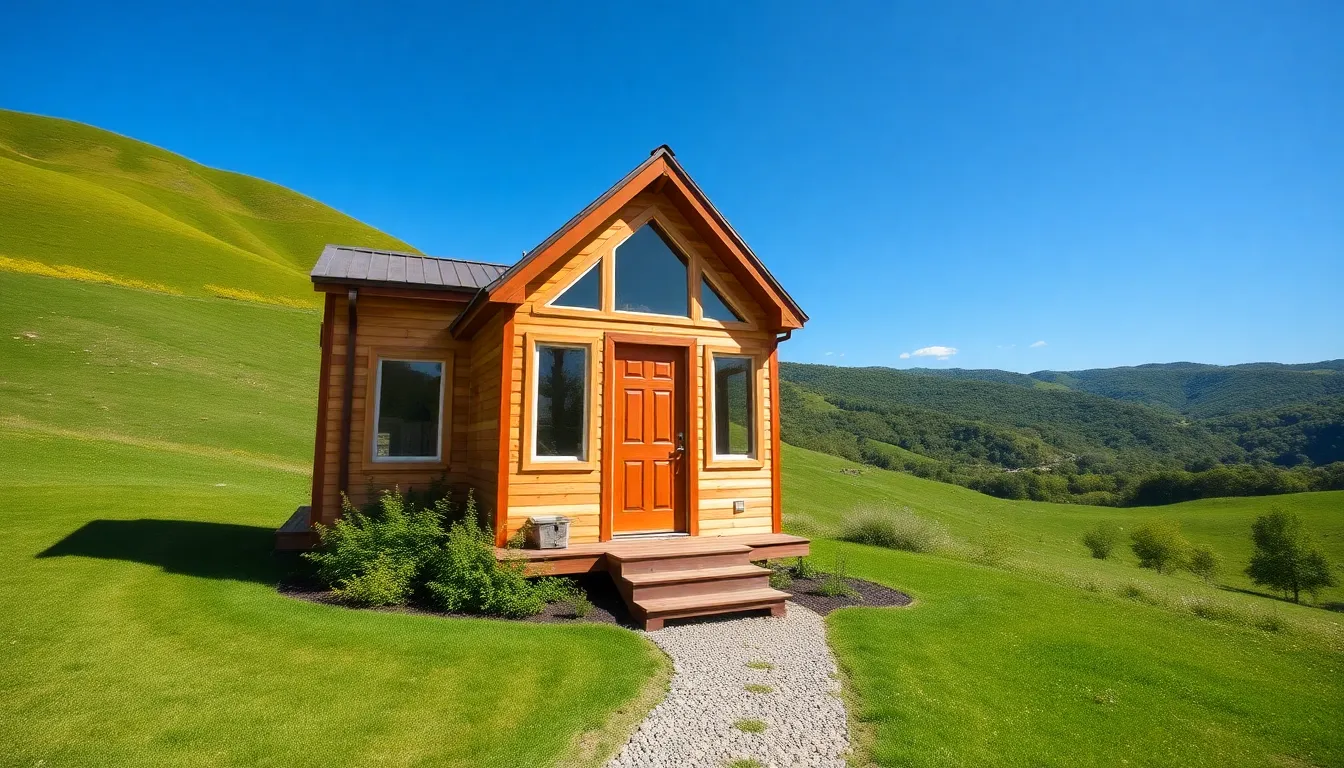In a world where bigger often means better, tiny home homesteading flips the script and proves that less really can be more. Imagine living in a cozy, charming space where every square foot serves a purpose, and your backyard is a mini farm bursting with fresh veggies. It’s not just about downsizing; it’s about embracing a lifestyle that’s sustainable, affordable, and downright adorable.
Table of Contents
ToggleWhat Is Tiny Home Homesteading?
Tiny home homesteading embodies a lifestyle choice that prioritizes simplicity and sustainability. Individuals seeking this path live in compact homes, often ranging from 100 to 400 square feet. This type of living fosters an environment focused on self-sufficiency. People engage in growing their own food, typically establishing gardens or mini-farms adjacent to their homes.
Existing structures used for tiny homes vary widely, including reclaimed shipping containers, trailers, and traditional tiny houses. Each option allows for creative design while maximizing functional space. Environmental sustainability remains a key benefit, as minimal energy consumption typically accompanies smaller living spaces. Residents contribute less to resource depletion, creating a lighter ecological footprint.
Homesteaders often practice permaculture principles. These principles promote working with nature to create productive ecosystems. Fresh vegetables frequently find their way to dinner tables, enhancing nutrition and reducing grocery costs. Many also engage in raising small livestock, such as chickens or bees, further diversifying their food sources.
Community plays a vital role in tiny home homesteading. Often, those involved share resources like tools and knowledge, fostering connections. Workshops and events frequently occur, reinforcing collaboration among like-minded individuals. This lifestyle encourages meaningful interactions, enhancing the social fabric.
Adopting tiny home homesteading unlocks opportunities for financial freedom. Lower housing costs typically accompany smaller footprints, allowing individuals to reduce debt and direct funds toward experiences rather than possessions. This emphasis on intentional living often leads to greater personal fulfillment and happiness.
Benefits of Tiny Home Homesteading
Tiny home homesteading brings numerous advantages, making it an appealing choice for many. Its emphasis on self-sufficiency and simplicity aligns with modern lifestyle trends.
Financial Freedom
Living in a tiny home means lower housing costs. Many individuals find they can save up to 50% on monthly expenses compared to traditional housing. With reduced mortgage payments and utility bills, financial burdens lighten significantly. This allocation of funds allows for investment in experiences, travel, or other passions. Flexible living arrangements often enable individuals to pursue alternative income sources, such as running small businesses or selling homegrown produce. Overall, tiny home homesteading can lead to a more secure financial future.
Environmental Impact
Smaller living spaces contribute to decreased energy consumption. Tiny homes typically use 45% less energy than average-sized homes. Sustainable materials often form the foundation of tiny home construction, reducing environmental footprints. By incorporating solar panels and rainwater collection systems, residents enhance their eco-friendliness. Growing food in gardens decreases reliance on commercial agriculture and the resources it requires. Together, these practices create a lifestyle that actively promotes environmental stewardship.
Simplifying Life
Minimalistic living encourages individuals to prioritize what truly matters. Downsizing allows for clarity, as people focus on experiences rather than material possessions. Clutter-free spaces foster mental well-being and increased creativity. Daily routines become simpler, with less time spent on maintenance and cleaning. As individuals cultivate gardens and connect with their surroundings, they encounter deeper fulfillment. Ultimately, tiny home homesteading invites people to embrace a more meaningful, intentional way of living.
Key Considerations for Tiny Home Homesteading
Tiny home homesteading encompasses various factors that require careful thought. Individuals must navigate specific challenges to create a sustainable lifestyle.
Zoning and Regulations
Zoning laws significantly affect tiny home homesteading. Local ordinances dictate placement and design, impacting where tiny homes can be situated. Each municipality has unique regulations that may require permits or limit home size. Researching these laws ensures compliance and avoids legal issues. Moreover, engaging with local zoning boards aids in understanding requirements specific to tiny homes. Many tiny home enthusiasts have successfully advocated for more flexible zoning regulations, paving the way for future residents.
Choosing the Right Location
Selecting an appropriate location is vital in tiny home homesteading. Factors such as accessibility to resources, climate, and community engagement must be considered. Ideally, a site near friends or family fosters strong support networks. Proximity to farmers’ markets or community gardens enhances access to fresh produce. Natural surroundings also contribute to sustainable living and outdoor activities. Evaluating local amenities and services ensures convenience and satisfaction in daily life.
Building Options
Building options for tiny homes vary significantly. Individuals can choose from various structures like reclaimed shipping containers, tiny house trailers, or traditional construction. Each option presents unique benefits and challenges regarding cost, durability, and mobility. Many prefer DIY projects to save money and personalize their space. Choosing energy-efficient materials enhances sustainability, aligning with homesteading goals. Consulting with builders who specialize in tiny homes provides valuable insight into the best design choices for individual needs.
Tips for Successful Tiny Home Homesteading
Successful tiny home homesteading requires strategic planning and execution across various aspects of daily life. Focusing on sustainable practices, maximizing space, and integrating technology enhances the overall experience and contributes to a fulfilling lifestyle.
Sustainable Practices
Implementing sustainable practices keeps tiny home homesteaders self-sufficient and eco-friendly. Growing organic vegetables and herbs reduces dependence on store-bought produce. Utilizing permaculture techniques can improve soil health while conserving water. Raising small livestock, such as chickens, not only provides fresh eggs but also creates natural fertilizer for gardens. Composting food scraps further minimizes waste while enriching the soil. Collecting rainwater for irrigation helps conserve resources, making it a valuable addition to sustainable living.
Maximizing Space
Maximizing space is essential in tiny home living. Utilizing multifunctional furniture, like convertible beds or collapsible tables, enhances usability without crowding. Strategic storage solutions, such as under-bed drawers or vertical shelving, optimize available areas. Creating outdoor living spaces, such as patios or garden sheds, extends functional areas beyond the home. Incorporating built-in storage features into walls provides additional room for essentials. Personalizing storage options fosters efficiency, ensuring every inch serves a purpose.
Integrating Technology
Integrating technology simplifies various aspects of tiny home homesteading. Smart home systems offer convenience through intuitive control of lighting and heating. Energy-efficient appliances conserve power while delivering necessary functions. Solar panels provide renewable energy, significantly reducing utility costs and reliance on conventional grids. Installing rainwater harvesting systems connects technology with sustainability, promoting resource conservation. Utilizing online platforms for community engagement fosters learning and collaboration, enhancing the homesteading experience.
Conclusion
Tiny home homesteading offers a unique opportunity to embrace a simpler and more sustainable lifestyle. By downsizing and cultivating a mini farm, individuals can enjoy fresh produce while significantly reducing their environmental impact. This approach not only fosters self-sufficiency but also encourages a stronger sense of community through shared resources and knowledge.
Financial benefits further enhance this lifestyle, allowing for reduced housing costs and greater freedom to invest in meaningful experiences. With careful planning and adherence to local regulations, tiny home homesteading can lead to a fulfilling way of life that prioritizes well-being and connection to nature. Embracing this trend can inspire others to rethink their living spaces and the impact they have on the world around them.







